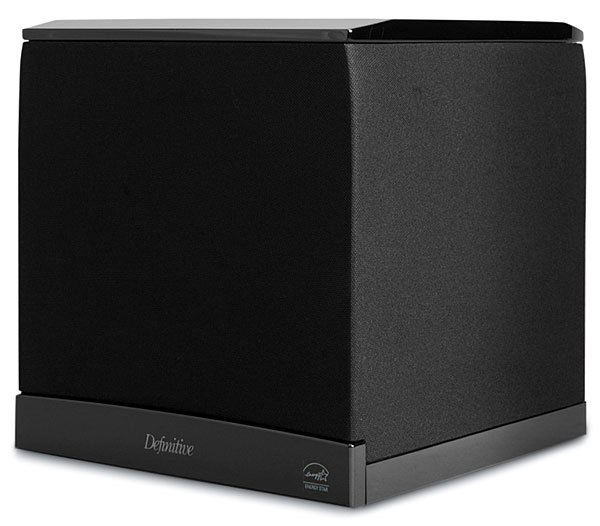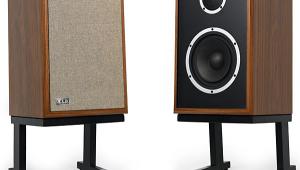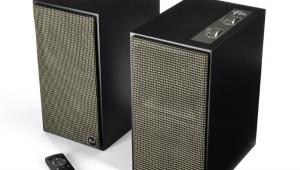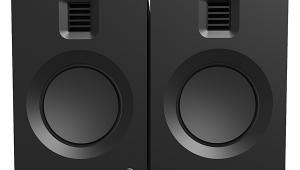Definitive Technology Demand Series D11 Speaker System Review

AT A GLANCE
Plus
Appealing neutral voicing
Laterally offset tweeter
Active 8-inch sub integrated in center speaker
Minus
D11 top radiators complicate placement of Atmos add-ons
THE VERDICT
The Demand Series lives up to Definitive Technology’s pedigree with satisfying, well-balanced sound that offers loads of resolution.
Nature abhors a vacuum, but wasting cabinet real estate is standard operating procedure among loudspeaker designers. With the notable exception of Atmos-enabled speakers and the occasional tweeter pod, the top panel of most speakers is a blank nothing. But does it have to be that way? Definitive Technology answered no, in effect, with its original Studio Monitor Series of bookshelf/stand-mount speakers (circa 2012) and does so again in this new update, the Demand Series. The D11 and D9 monitors (the former reviewed here) employ reflex enclosures that locate a passive radiator on the top panel in lieu of a more compact port, which would commonly be located elsewhere on the cabinet. Even more provocatively, the CS9060 center the company mated with our system includes an active driver on top, essentially augmenting the system’s subwoofer needs. A D-shaped indicator on the CS9060’s front illuminates when the active sub driver is active. I’ve never reviewed such a thing before. But it makes me see the vast desert of space found atop the typical horizontal center in a new and more skeptical light.
United They Stand
Definitive Technology was founded in 1990 and has landed numerous products on our Top Picks list since the brand’s inception. It is now part of the Sound United stable that also includes Polk Audio, Denon, HEOS, Marantz, and Boston Acoustics. Products are designed in San Diego, California and at a combined Definitive Technology and Polk engineering facility in both brands’ old hometown of Baltimore, where many of the same longtime engineers remain employed.
Long known for its fabric-wrapped towers and sometimes unorthodox designs, Definitive offers a wide variety of speakers. Towers include the well-regarded Mythos line and BP9000 bipolar towers. Also offered are numerous monitors, centers, subwoofers, and speaker packages. The Wireless Collection line includes two soundbars, two standalone speakers, and both preamp and powered player modules. The company also markets a full line of other soundbars as well as fully developed lines of in-walls, on-walls, outdoor speakers, and headphones.
The new Demand Series includes three monitors: the D11 ($999/pair), D9 ($749/pair), and D7 ($499/pair). They include 6.5-inch, 5.25-inch, and 4.5-inch woofers, respectively, along with 1-inch aluminum dome tweeters; as noted, the top two models also sport topmounted passive radiators, while the smallest has a rear port. Our review system used a pair of the D11 in front and a pair of the D7 in back.

The somewhat unorthodox CS9060 in the center position was introduced in 2016 to complement Definitive’s then-new BP9000 series of updated bipolar tower speakers. The speaker’s horizontal front-firing 4.5-inch woofer-tweeter-woofer array is beefed up by a top-firing 8-inch powered woofer, complete with its own LFE line input. Feed this with the RCA subwoofer output from your AVR, and it might make an outboard sub unnecessary in some small rooms, or supplement a freestanding sub in a two-sub system. Otherwise, eschew this connection, and the active woofer will simply bolster the bottom of the center’s output when used with a conventional crossover and dedicated sub. A possible downside to building the sub into the center is that it limits placement to a single fixed position that probably is not optimized for bass reproduction. Furthermore, that spot might just be inside a cubby, the confines of which could restrict output from the upfiring driver and rear port, or on a shelf that might rattle if pounded with bass beyond what’s expected of most center speakers. However, in my setup, the center fired up unrestricted toward the high plaster ceiling, and I could place our system’s standalone sub— Definitive’s long-established SuperCube 6000—in the usual spot where experience told me it would work the best.
The Demand Series monitors are pleasantly and unabashedly dressy-looking, with black gloss enclosures accented by a “bead blasted” extruded-aluminum baffle that wraps around the sides for an inch or so. The CS9060 is wrapped in fabric, in the Definitive tradition, with aluminum side accents.
The tweeter used in the Demand Series features an integrated phase plug that Definitive calls their 20/20 Wave Alignment Lens, plus a shallow waveguide to control on- and off-axis response. In a not-unheard-of but somewhat uncommon design twist, the acoustical center of the tweeters are laterally offset from the centerline of the cabinet toward the outer edge; hence, they are sold in mirror-imaged left/right pairs only. Incorporating a lateral offset places the tweeters at varying distances from each cabinet edge, where a particular form of diffraction typically occurs. Normally, a reflection or bending of a sound wave coming off the driver is caused when the wave abruptly encounters the change in acoustics that occurs where the sharp edge of the baffle meets the surrounding air. This will generally cause uneven response at frequencies determined by the baffle dimensions. If the distance to each of these edges is the same, as it is with a centered tweeter, the effect from each of the three nearest baffle dimensions will be at the same frequency, which piles up and can potentially cause a large dip in the axial response at a single frequency. By offsetting the tweeter, you get smaller dips at multiple frequencies, creating more of a ripple than a large dip, which many argue is psycho-acoustically preferable.
The woofers in all three speakers include phase plugs and what Definitive calls a Balanced Double Surround System that’s said to improve linear cone excursion. In what amounts to the Demand Series’ other notable design feature, the D11’s large 6 x 10-inch oval passive radiator (with cloth grille matching the front baffle’s), used in lieu of a port, is mounted on the speaker’s top—the only exposed panel area available to squeeze it into. By their nature, the top-mounted passive radiators also prevent the cabinet tops from accommodating Dolby Atmos add-on elevation modules (though if you’re determined to add immersive sound without wiring ceiling speakers, you might successfully place these near, but above, the mains on a different supporting surface). In any event, this limitation did not impair our review’s 5.1channel configuration. On the back of the D11 are gold-nut biamp-ready bridged binding posts, and on the rear of the D7, a single set of posts. The CS9060 has a single pair of speaker terminals plus the line-level RCA jack for optional LFE input and a power connector for the Class D amplifier driving its integral sub; the bass-reflex cabinet incorporates a rectangular vent on the rear.
The D11 monitor and CS9060 center are rated at 90 and 91 decibels sensitivity, respectively, on the high side of average. Rated sensitivity of the ported D7 monitor is considerably lower at 85 dB, but a good receiver should have little trouble driving it, especially if you use it just for the surround channels (as we did). See our Test Bench results below.

The SuperCube 6000 sub ($999), reviewed favorably in 2012 by my colleague Darryl Wilkinson as part of a StudioMonitor system test (available at soundandvision.com), augments its front-firing 9-inch woofer with two side-firing 10-inch passive radiators. The Class D amp is rated at 1,000 watts RMS and 1,500 watts peak with a 56-bit DSP on board. Fabric grilles cover all drivers, while the top piece and bottom trim are gloss black. A supplied card remote includes controls for EQ mode, night mode, low-pass filter, phase, display dimming, volume, mute, and power, allowing the enormous luxury of tweaking from your seat. You’ll have no trouble reading settings on the front-panel display in letters and numbers nearly an inch tall and in bright red. The display can be turned on or off but not dimmed.





























































